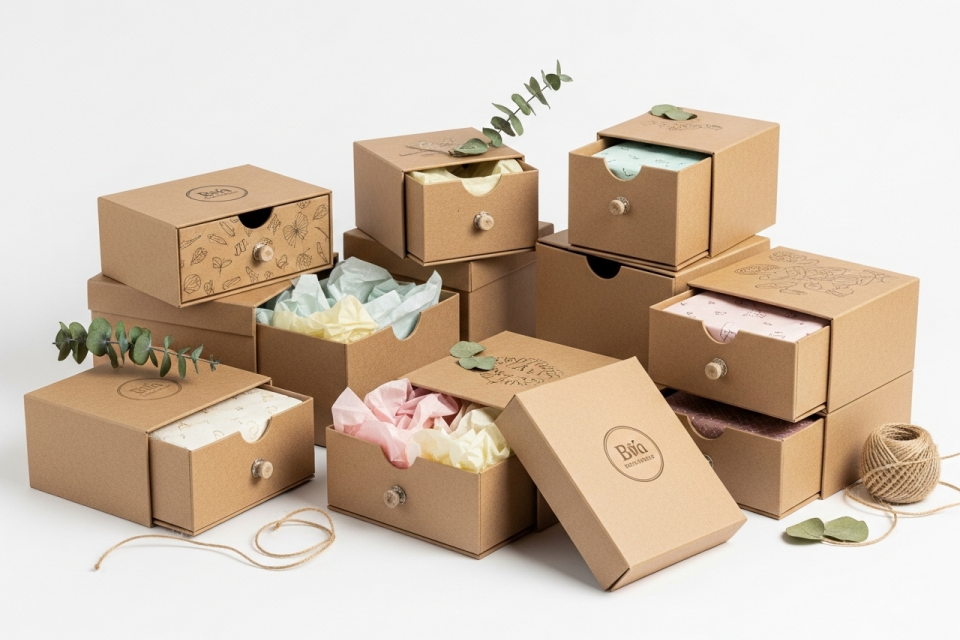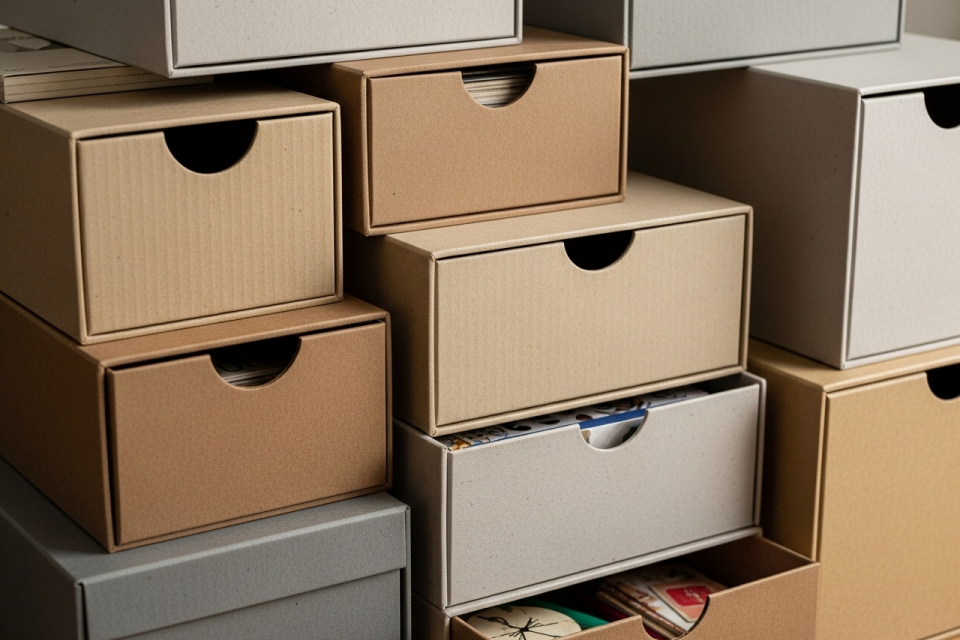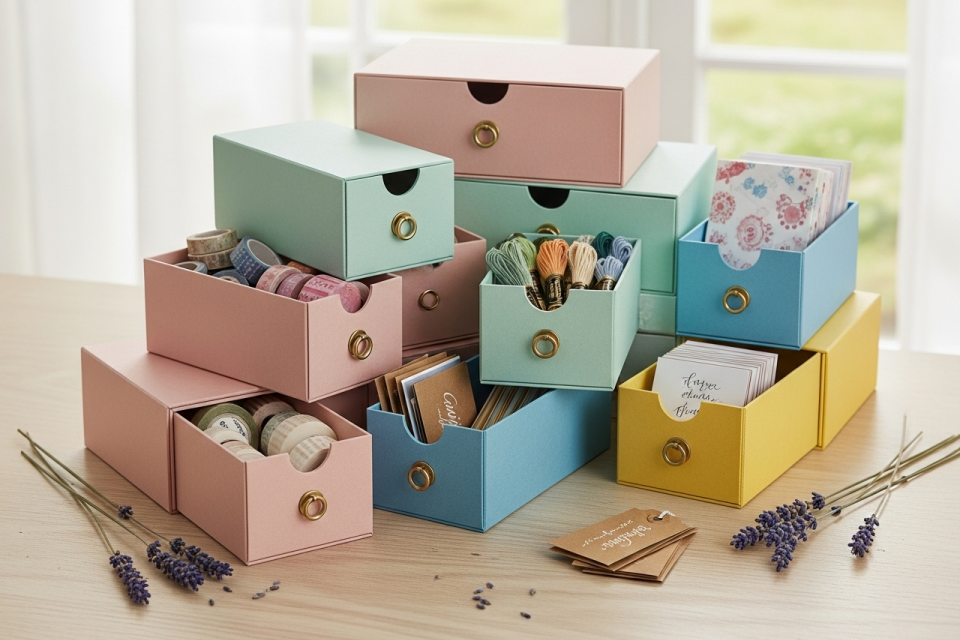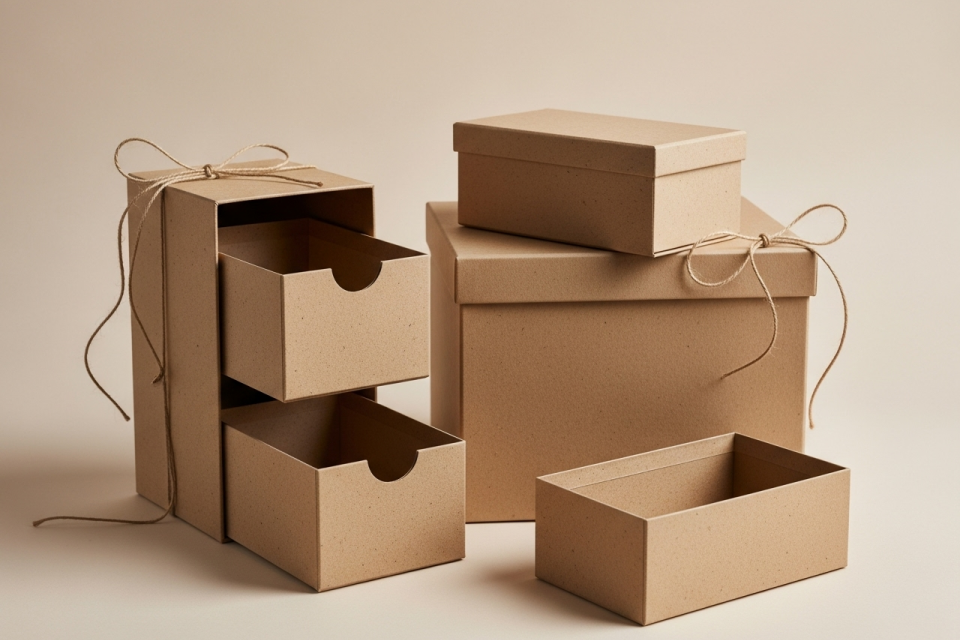Benefits of Drawer-Style Packaging
This blog explores drawer-style packaging from its history to future trends. Learn how it boosts user experience, sustainability, and brand identity in a competitive market.
Summary
Drawer-style packaging is an innovative design approach that offers both aesthetic appeal and practical functionality for a wide range of products. Characterized by its unique sliding mechanism, this type of packaging enhances the unboxing experience and provides convenience for consumers, making it increasingly popular across various industries, including cosmetics, electronics, and e-commerce. The design not only showcases products effectively but also reflects a brand’s commitment to quality and sophistication, positioning drawer-style packaging as a desirable option for high-value and sensitive items.
The rise of drawer-style packaging can be attributed to evolving consumer preferences, particularly the demand for sustainable and user-friendly solutions. Made primarily from eco-friendly materials like kraft paper, drawer boxes are recyclable and often produced with minimal environmental impact, aligning with the growing trend toward sustainability among consumers. Additionally, the convenience of easy access contributes to a positive customer experience, fostering brand loyalty and repeat purchases.
However, while the benefits of drawer-style packaging are numerous, there are also challenges associated with its adoption. The complexity of production and higher associated costs compared to traditional packaging methods can pose barriers for some businesses. Furthermore, as competition in the packaging industry intensifies, brands must continuously innovate to maintain their appeal and differentiate themselves from competitors. Balancing aesthetic design with practical usability and sustainability remains a critical focus for companies looking to implement drawer-style packaging effectively.
In summary, drawer-style packaging is not just a functional solution but also a strategic marketing tool that enhances consumer engagement and brand identity. Its growing prominence reflects broader trends in consumer behavior, sustainability, and technological advancements, making it a significant consideration for businesses aiming to thrive in a competitive market.
Table of Contents
History
Early Developments in Packaging
The origins of packaging can be traced back to ancient civilizations, where materials such as animal skins, leaves, and woven fibers were utilized for basic containment and transportation purposes. The ancient Egyptians were among the pioneers in the creation of glass containers, while early Chinese societies developed paper-making techniques as early as the 2nd century BC, using paper as lightweight packaging for tea and other valuables. These early forms of packaging laid the groundwork for more sophisticated packaging solutions that would evolve over the centuries.
Evolution of Packaging Materials
By the 18th century, the use of paper packaging began to expand, particularly with products like tobacco, where packages were crafted from paper with internal wireframes to facilitate storage and use. The innovation of carton materials in the late 19th century marked a significant turning point; Robert Gair, a Brooklyn printer and paper bag maker, inadvertently created the first automatically made carton while working on seed bags. This development led to the rise of “semi-flexible packaging,” enhancing both production efficiency and product protection.
The Modern Packaging Era
The end of World War II ushered in a new era for packaging, characterized by the introduction of new materials such as aluminum foil and the adoption of single-use packaging solutions. During this time, packaging became a powerful sales and marketing tool, with brands increasingly focusing on design and branding to attract consumers. The emergence of plastics in the early 20th century further transformed the landscape of packaging, making it a primary material for products worldwide.
The Rise of Drawer-Style Packaging
In recent decades, drawer-style packaging has gained popularity for its unique design and functionality. This style not only serves to protect the product but also enhances the unboxing experience, creating a sense of luxury and sophistication for the consumer. The design incorporates structural elements that build anticipation, combining both aesthetic appeal and practical use. As brands recognize the importance of presentation, drawer-style packaging has become a preferred choice in various industries, particularly for high-value and sensitive items.

Advantages
Drawer-style packaging, particularly paper drawer boxes, offers several significant advantages that enhance both consumer experience and brand perception.
Convenience
One of the primary benefits of drawer-style packaging is its convenience. These boxes are designed for easy access, allowing users to effortlessly slide out the contents without hassle, which significantly improves the unboxing experience. This ease of use not only provides a pleasant first impression but also reflects the brand’s commitment to consumer satisfaction.
Sustainability
Sustainability is another critical advantage of drawer-style packaging. Made from kraft paper, these boxes are generally more eco-friendly than their plastic counterparts. They are recyclable and often produced with minimal environmental impact, aligning with the increasing consumer preference for sustainable products. Brands that utilize such packaging can enhance their image as environmentally responsible, appealing to eco-conscious consumers.
Cost-Effectiveness
In terms of cost, drawer-style boxes are often less expensive to produce than more rigid packaging options. This reduced cost can be beneficial for brands looking to maximize profit margins while maintaining quality packaging. Additionally, the sturdy nature of kraft paper makes these boxes strong and durable, protecting products during transit and storage.
User-Friendly Features
Drawer-style packaging incorporates user-friendly features that enhance functionality. These designs typically allow for easy opening and returning, catering to consumer needs for practicality and accessibility. This approach not only promotes a positive consumer experience but also encourages repeat purchases, as customers are likely to return to brands that prioritize usability.
Emotional Connection
The design and tactile experience of drawer-style packaging can create emotional connections with consumers. The pleasing aesthetics, combined with functional features, contribute to a memorable interaction that enhances brand loyalty. Brands that effectively utilize these elements can create a powerful marketing tool through their packaging, further solidifying their identity in the consumer’s mind.

Applications
E-commerce Enhancement
Drawer-style packaging has gained prominence in the e-commerce sector due to its ability to offer a seamless unboxing experience that engages consumers from the moment they receive their product. The design facilitates easy access to items while minimizing packaging waste, aligning with the growing demand for sustainability among consumers. E-commerce businesses can leverage this type of packaging to improve customer satisfaction, as the intuitive design enhances the overall shopping experience by making the retrieval of products quick and hassle-free.
Retail Strategies
In retail environments, drawer-style packaging provides a distinct advantage by standing out on shelves and attracting consumer attention. This type of packaging allows brands to showcase their products in a way that enhances brand identity and communicates the product’s unique selling proposition (USP) effectively. By using custom designs that reflect brand values, retailers can differentiate their offerings from competitors, increasing the likelihood of purchase. Retailers can also utilize technology, such as QR codes and augmented reality (AR) features integrated into the packaging, to provide additional product information and interactive experiences that engage customers at the point of sale.
Personalization and Customization
The versatility of drawer-style packaging allows for a high degree of personalization, catering to specific consumer preferences. Brands can implement digital printing techniques to create custom designs that resonate with target audiences, thus fostering an emotional connection and enhancing customer loyalty. Additionally, the ability to incorporate elements such as sensory stimulation—through textures or scents-can elevate the unboxing experience further, making it more memorable and engaging.
Technological Integration
As the digital landscape evolves, integrating technology into drawer-style packaging has become a key trend. Enhanced features, such as NFC and RFID technology, not only provide consumers with information about product origins and authenticity but also improve inventory management for retailers. This technological aspect can create a bridge between the digital and physical shopping experiences, enhancing overall consumer engagement and driving sales.
Sustainability Considerations
With increasing consumer awareness regarding environmental issues, drawer-style packaging is often designed with sustainability in mind. By utilizing eco-friendly materials and reducing excess packaging, brands can cater to the growing segment of environmentally conscious consumers. This alignment with sustainability values can enhance brand reputation and consumer trust, driving loyalty and repeat purchases.

Comparisons
Advantages of Drawer-Style Packaging
Drawer-style packaging offers several notable advantages compared to traditional packaging methods. One significant benefit is its versatility and customization options, allowing brands to tailor designs that reflect their identity and appeal to target consumers. This adaptability extends to aesthetics, where drawer boxes can complement various design themes, enhancing the overall presentation of the product.
Additionally, the enhanced user experience provided by drawer packaging stands out as a key differentiator. Unlike conventional packaging that often requires tearing or cutting, drawer boxes allow for easy access to the product, improving consumer satisfaction and potentially influencing repeat purchases. The secure design of drawer packaging also protects sensitive or valuable items, minimizing damage during transit and ensuring the product arrives in pristine condition.
Environmental Considerations
In an era where sustainability is increasingly prioritized, drawer-style packaging can be produced using eco-friendly materials, aligning with consumer preferences for responsible packaging solutions. This environmental responsibility is becoming a competitive edge, as brands that adopt sustainable practices often attract environmentally conscious buyers. By reducing waste and opting for recyclable materials, drawer-style packaging can minimize its carbon footprint throughout its lifecycle.
Disadvantages and Limitations
Despite its benefits, drawer-style packaging is not without its challenges. The production cost can be higher due to the complexity of the design and materials used, making it less favorable for bulk packaging compared to simpler alternatives. Furthermore, while the aesthetic appeal is a strong selling point, it is essential for brands to balance design with functionality to ensure that the packaging meets practical consumer needs.

Challenges
While drawer-style packaging offers numerous advantages, it also presents several challenges that businesses must navigate to ensure successful implementation and consumer satisfaction.
Cost Considerations
The cost of drawer-style packaging can also be a barrier for some businesses. While these packages often enhance brand perception and customer experience, they tend to be more expensive than basic packaging solutions due to their customized nature and production requirements. Businesses need to carefully evaluate whether the benefits of increased customer satisfaction and brand differentiation outweigh the higher costs associated with drawer-style designs.
Production Complexity
One of the primary challenges of drawer-style packaging is its production complexity. Unlike standard packaging options, drawer-style designs require more intricate manufacturing processes, including precise cutting and assembly. This complexity can lead to longer production times and increased costs if not managed properly. Advanced technologies, such as automatic visual positioning production lines and fully automatic die-cut machines, help mitigate these issues by enhancing precision and efficiency. However, not all manufacturers may have access to such technologies, potentially limiting their ability to produce high-quality drawer-style packaging at scale.
Sustainability Concerns
Sustainability is an increasingly critical issue for packaging, and drawer-style packaging is not exempt from scrutiny. Although many manufacturers are adopting eco-friendly materials and practices, the production processes for these boxes can still generate waste and environmental impact if not handled properly. Companies must strive to balance aesthetics with sustainability, ensuring that their packaging choices are responsible and align with consumer expectations for eco-friendly products.
Consumer Expectations
As consumer preferences evolve, the demand for convenience and functionality in packaging grows. While drawer-style packaging can enhance the unboxing experience, it must also meet practical usability standards. Consumers increasingly expect features such as easy opening, resealability, and convenience in storage, which may not always align with the design of more complex packaging solutions. Brands that fail to consider these aspects may risk disappointing their customers, undermining the intended benefits of the packaging design.
Market Competition
Finally, businesses face intense competition in the packaging industry, where differentiation is key. As more brands adopt innovative packaging solutions, standing out becomes increasingly challenging. Companies must continuously innovate and improve their drawer-style designs to capture consumer attention and loyalty, which can place additional pressure on resources and creativity.
Future Trends
The future of drawer-style packaging is set to be influenced significantly by sustainability, technology, and consumer preferences. As brands adapt to changing market dynamics, the emphasis will increasingly be on environmentally-friendly solutions that not only meet regulatory demands but also resonate with consumer values.
Sustainable Innovations
Sustainability will remain at the forefront of packaging design trends. Innovations in materials will be crucial; for example, the use of recycled cardboard and biodegradable materials in drawer-style packaging is expected to rise, aligning with the growing demand for eco-friendly options. Companies are likely to explore creative ways to incorporate these materials while ensuring that the packaging remains aesthetically appealing and functional. Moreover, the incorporation of reusable elements, such as resealable closures, can extend the life of drawer-style packaging, providing added value to consumers while minimizing waste.
Technological Integration
The integration of advanced technology in packaging production will also shape future trends. Automation and smart manufacturing processes, including 3D printing, are anticipated to streamline production and reduce material waste. Additionally, the adoption of digital printing techniques will allow for highly customizable designs without the environmental impact of traditional methods, enabling brands to create unique packaging that meets specific consumer needs. These technologies will not only enhance the efficiency of production but also improve the overall sustainability of packaging solutions.
Consumer-Centric Design
As consumer preferences continue to evolve, packaging design must prioritize user experience. In 2024, brands are expected to shift their strategies towards creating packaging that offers a premium experience, with drawer-style packaging being no exception. Feedback from consumers will play a crucial role in shaping the future of packaging design, leading to innovations that enhance product safety, usability, and visual appeal. Customization will become increasingly important, allowing brands to differentiate themselves in a crowded market by offering tailored solutions that cater to individual customer preferences.
Economic Considerations
The economic landscape will also influence drawer-style packaging trends. As the cost disparity between traditional and sustainable packaging narrows, companies may find it more financially viable to adopt eco-friendly options. This shift is driven by not only advancements in production technology but also increasing regulatory pressures that favor sustainable practices. Furthermore, rising consumer demand for environmentally responsible products will encourage brands to invest in sustainable packaging solutions, leading to economies of scale that reduce costs and enhance competitiveness in the market.
